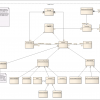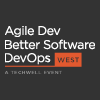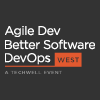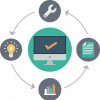 |
Requirements Mapping Using Business Function Test Suites On this team, testers were overcommitted, avoidable defects were surfacing, and documentation was hard to find. Worse, trust and morale were low. Upgrading tools was out of the question, so the testers decided to take matters into their own hands and create incremental change themselves. Here's how a team added a new type of traceability to its requirement test case world.
|
|
 |
Elegant Test Weapons for a More Civilized Age
Slideshow
Software Engineering as a discipline is always evolving. The technologies and tools that were in vogue yesterday are passé today and gone altogether tomorrow. Despite this high churn, there are a number of skills that software testers, in particular, possess that are eternally useful. They cut across time and tools and even job titles. Melissa will help software testers look past technologies and titles to explore the skills that they may already possess that are in high demand. She will explain some of the hottest job titles and technologies in the market today, and go in-depth into what skills many software testers already hold that uniquely qualify them for these positions. In the most cutting-edge software companies – from startups to megacorps – traditional software testing functions have been encompassed in roles that might not be immediately obvious.
|
Melissa Benua
|
 |
Influencing Stakeholders Using Fact-based Information
Slideshow
With all the open source tools available on the market it can be overwhelming as to which ones might meet your needs and which ones will work best in your environment to create a high performing team and metrics dashboard. Join Jennifer as she explains the relationship of data, your environment, and how a hub and spoke model can link all your different data sets and tools together. She identifies opportunities for applying test data analytics across the engineering and test landscape, ranging from high-value test cases to dynamically generated regression test suites. She will review ways to collaborate and show results in a way that clearly demonstrates progress and how to present a visual metrics dashboard to your leadership and stakeholders in the organization.
|
Jennifer Bonine
|
 |
Aligning Zero-Touch Nonfunctional Testing in DevOps Implementation
Slideshow
When a host of applications and data centers get migrated from their traditional IT systems to a cloud-based data center using an automated DevOps model of deployment, effective testing is critical to success. True DevOps value is realized when all development, testing, and operations functions collaborate and operate on a zero-touch automation model. In this session, Subash Newton will review the prerequisites for creating an effective DevOps testing strategy that includes nonfunctional testing. He will share how to set up an effective test strategy using a zero-touch process automation framework that dramatically increases test automation efficiency.
|
Subash Newton
|
 |
Taking Your Automation Framework to the Next Level Using Machine Learning
Slideshow
Automation fails frequently in companies due to a variety of reasons, including poor team communication, lack of skills, flaky tests, and inadequate understanding of test coverage. Even when things are going well, the automated tests sometimes grow to a size where the test suites take too long to execute for the run to be viable. James Farrier is a test automation architect who will show you ways to leverage machine learning to address these challenges. You'll learn how to determine which tests are valuable to run after each commit or build in order to cut down the suite run time, how to automatically close and open defects based on test run results, and how to separate a test into different test runs to keep track of tests in different states. Finally, he will show you how to create a results dashboard that allows for team collaboration and a better understanding of test coverage so that testing can be further streamlined.
|
James Farrier
|
 |
API Testing: How to Write Tests, Integrate into CI, and Track What You're Testing
Slideshow
Some developers and testers think that APIs, whether internally developed or not, should just work. Unfortunately, without a significant amount of focus on testing API services, one little flaw can spell disaster for your application—especially security vulnerabilities where hackers will target your application. Elise Carmichael discusses the risks of not fully testing APIs, how to be sure that all services are tested fully, and the types of negative testing you need to do on APIs. She shows you a method to organize your tests using Postman, a tool for REST web services testing. During this session, Elise and the participants will write some Postman API tests with variables and then execute the tests with Newman, a command line application for running Postman tests that you can include in continuous integration scripts.
|
Elise Carmichael
|
 |
Five Things We’ve Learned from 100,000 Bug Fixes
Slideshow
[video:https://youtu.be/GRXNPt2IAyY width:300 height:200 align:right]
|
Kristel Kruustük
|
 |
Migrating from Test Cases to Real-World Telemetry Measures
Slideshow
Ken Johnston sees today’s software ecosystem in the light of Everything as a Service (EaaS). Operating systems like Windows, Android, and Chrome OS all ship regularly like a service. Browsers automatically update every few weeks, and apps are constantly updating through all the app stores. Although getting a test to pass once and signing off has gone by the wayside for software testing, still we run test cases over and over again. Ken shares how Microsoft took millions of test cases—yes, actually millions—and turned the important ones into measures based on real world telemetry. Massive amounts of data coming in from real devices and real users measure product quality and tie it to key customer satisfaction metrics.
|
Ken Johnston
|
 |
Transformation from QA to Engineering: Testing in the Fast Lane
Slideshow
[video:https://youtu.be/IavieFiAUYI width:300 height:200 align:right]
|
Jennifer Scandariato
|
 |
4 Strategies for a Structured QA Process Being a software tester is no longer just about finding bugs. It is about continuous improvement, defining a clear test strategy, and going that extra mile to improve quality. Following a consistent, structured approach to QA will help you acquire more knowledge about the product you are testing, ask questions you otherwise may not have thought of, and become a true owner of quality.
|
|

